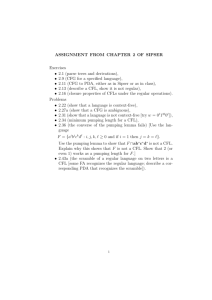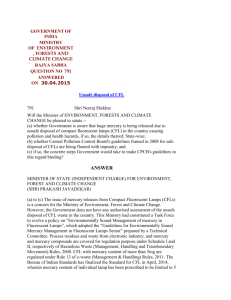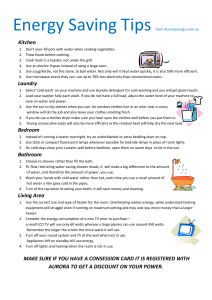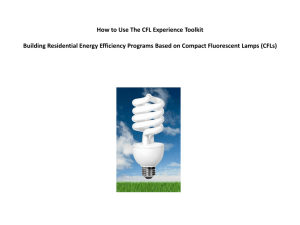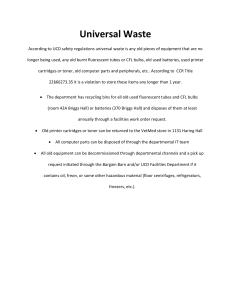What is DEER?
advertisement
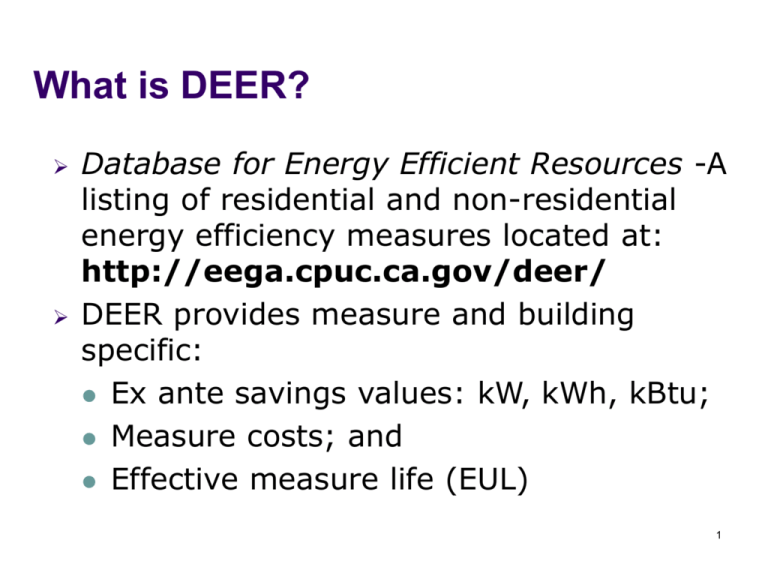
What is DEER? Database for Energy Efficient Resources -A listing of residential and non-residential energy efficiency measures located at: http://eega.cpuc.ca.gov/deer/ DEER provides measure and building specific: Ex ante savings values: kW, kWh, kBtu; Measure costs; and Effective measure life (EUL) 1 Non-Weather Sensitive Residential Measures Include: CFL Lighting Refrigerators Clothes Washers & Dryers Dishwashers Water Heating Swimming Pool Pumps 2 Non-Weather Sensitive Res. Measures Residential CFL Savings CFL savings impact = (delta watts/unit * hours/day * days/year * In Service Rate) / 1000 watts/kWh CFL demand impact = delta watts/unit * In Service Rate * Peak Hour Load Share The “In Service Factor” is an estimate of the percentage of lamps that are actually used. “Hours of Operation/Day” and “Peak Hour Load Share” from KEMA CFL Metering Study. For example (14W CFL replace 60W Inc): CFL savings impact = 35.4 kWh (46W * 2.34 hours/day * 365 days/year * 0.9) / 1000 watts/kWh CFL demand impact = 3.35 W 46W * 0.9 * 0.081 3 Non-Weather Sensitive Res. Measures Residential Water Heating Measures High efficiency water heater (electric EF=0.93, gas EF=0.63) Heat pump water heater (EF=2.9) Point of use water heater Low flow showerhead (from 2.5 to 2.0 gallons per minute) Pipe wrap Faucet aerators Savings expressed as % of base use Base use varied by utility service area (same method as 2001) 4 Non-Weather Sensitive Non-Res. Measure Groups Interior Lighting Exterior Lighting Cooking Copy Machine Water Heating Vending Machine Controls High Efficiency Motors Agriculture 5 Non-Weather Sensitive Non-Res. Measures Interior Lighting Group: CFL screw-in lamps CFL hardwire fixtures High intensity discharge (HID) lamps Premium T8 lamps Dimming Ballasts De-lamping fluorescent 4 ft and 8 ft fixtures 6 Non-Weather Sensitive Non-Res. Measures Exterior Lighting & Exit Signs Methods HID lamps: delta watts saved * hours of use (4,100 hours) no peak impacts Exit Signs: delta watts saved * 8760 hours * Interactive Effects peak = delta watts * Interactive effects * 1.0 (coincidence factor) Timeclocks & Photocells: watts controlled * hours of control no peak impacts 7 Weather Sensitive Measures Methods Used Employed DOE-2/eQUEST heat load simulation model • Hourly simulation of all elements • Includes details of configurations Measures include high efficiency AC, furnaces, controls, shell measures, and maintenance (for single family, multi family, mobile homes and 22 non-res. building types, in each of 5 building vintages, for 16 climate zones). 8 Weather Sensitive Measures Calibration Residential • Residential Appliance Saturation Survey (RASS) used to calibrate end-use values Non-residential • Adjustments both at “activity area” and whole building level using preliminary Commercial Energy Use Survey (CEUS) values and values from EM&V studies 9 Weather Sensitive Measures Simulation cases Base case • Vintage typical base on survey data Code base Case • Minimally compliant or standard practice Measure Case • Most common program tier's 10 Overview of 2001-2005 Data Changes The scope of some measures has been expanded • • • Several measures eliminated or reduced in scope • • CFL size categories expanded More evaporative cooler options Windows expanded to include non-res. high performance glazing Most T8 systems eliminated with the exception of premium efficiency and dimming T8 ballasts Eliminated coin-operated high efficiency clothes washers and hot water heater tank wrap Major changes in savings for some measures • • • • Programmable thermostats CFLs Low flow showerheads AC units 11 Defining Measure Cost Parameters Measure costs specifications encompass the sizes and technical specs of measures used in the energy analysis, but reflect availability of products on the market Cost data is first cost only -- life cycle or O&M costs/cost savings not included Some price observations (outliers) excluded; rational purchasing policy assumed (“who would pay THAT?”) Equipment and labor prices are specific to California to extent possible (average across state) Cost units ($ / ton, $ / HP, $ / square foot, etc.) • Mostly the same although different for some measures • Distinct field in detailed cost data; appended to Cost Basis designator in measure detail 12 Cost Data Defining Cost Parameters How to find the most applicable cost information? • Measure detail pages for each run ID - the per unit equipment measure cost of $13.65 for all 90% residential furnaces • This provides an average cost based on a 100,000 Btu furnace • The ‘Cost Data’ file under ‘Supporting Documents’ provides prices on a range of furnace sizes • This provides a range of costs for 90% AFUE furnaces from 60,000 Btu to 140,000 Btu. Per unit costs ($/KBtu) ranges from $21.53 to $12.13, respectively • The cost workbook section – Can use either statistical summary or individual price observations • For example, the per unit equipment measure cost for 90% AFUE 100,000 furnaces ranges from to $12.31 to $16.52 based on 9 observations 13 Website Considerations Two Levels of Savings Customer savings - for system savings and early replacement savings. “Above Code” Savings - for all measures affected by an energy code or standard (reportable savings for replace on burnout.) Common Units The energy and cost common units are distinct Over 90% of cases, they are the same When different, distinctly identified 14 Website Considerations Application – indicates if the cost is for: • Retrofit (RET) - replacing a working system with a new technology or adding a technology. • Replace-on-burnout (ROB) - replacing a technology at the end of its useful life • New construction or major renovation (NEW) - installing a technology in a new construction or major renovation Cost Basis – indicates if the cost is: • Incremental (INCR) - the differential cost between a base technology and an energy efficient technology • Installed (FULL) - the full or installed cost of the measure including equipment, labor, overhead & profit (OH&P) 15 Website Navigation – Opening Screen 16 Website Navigation – Browse Measures 17 Website Navigation – Select Subcategory 18 Website Navigation – Review Summary Page - Top 19 Website Navigation –Summary Page Information Area #1 - Summary Identification of 13 variables Area #2 – Further Filtering Options Climate Zone, Building Type, Vintage, Savings Unit Area #3 – Sorting Order Area #4 – Download Measure Detail in Excel 20 Website Navigation – Review Summary Page - Bottom 21 Website Navigation – Detailed Measure Information 22 Website Navigation – Detailed Measure information - Top 23 Website Navigation – Detailed Measure information - Bottom 24 Supporting Documents Section Website Users Guide Net-to-Gross Ratios Table (if in doubt use .8) Access Tables Glossary Cost Data Cost Data User’s Guide New EUL Estimates (7-14-05 SERA Report) Consolidated Measure Data 25
